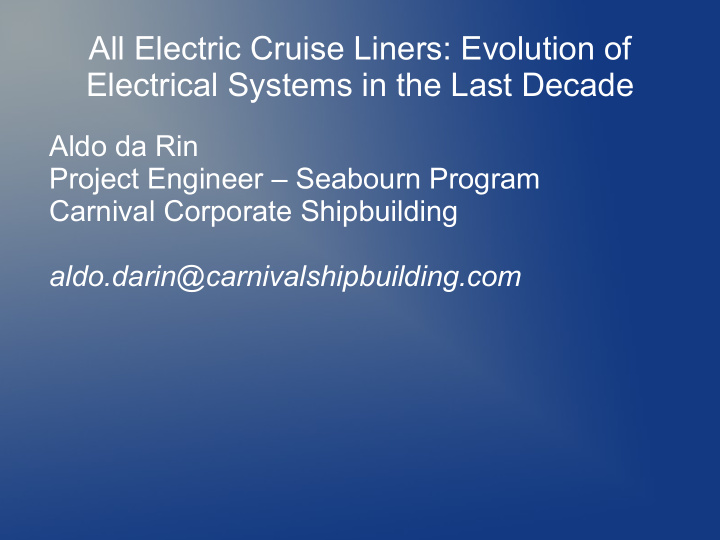



All Electric Cruise Liners: Evolution of Electrical Systems in the Last Decade Aldo da Rin Project Engineer – Seabourn Program Carnival Corporate Shipbuilding aldo.darin@carnivalshipbuilding.com
All Electric Cruise Liners: Evolution of Electrical Systems in the Last Decade First experience (1995): ● One 6.6kV switchboard with SF6 circuit breakers and analogue single function protection relays. ● Radial network with 440V low voltage and two winding cast resin transformers. ● 1000V Cyclo drive with 4 propulsion transformers (and electromechanical harmonic filtering on bigger units). ● Inboard synchronous propulsion motors with controllable pitch propellers. ● Low power factor (0.7) synchronous generators.
All Electric Cruise Liners: Evolution of Electrical Systems in the Last Decade Power Distribution ● Rated voltage is now 11kV ● Digital multifunction protection relays are exclusively used, and their communication features exploited ● Vacuum contactors and circuit breakers have been used with success. ● High voltage switchboards are usually two, interconnected with an medium voltage line. A more fault tolerant structure.
All Electric Cruise Liners: Evolution of Electrical Systems in the Last Decade Network architecture. ● Some examples of radial 11kV distribution lines have been seen (Queen Mary 2, Aida Project). ● Multiple winding (11/0.69/.23 kV) transformers are becoming more and more common. ● Low voltage have been raised to 690V from 440V. 440/690V transformers are installed to enable power from shore in locations not embracing 690V standard
All Electric Cruise Liners: Evolution of Electrical Systems in the Last Decade Propulsion. ● Cyclo-converter has almost completely disappeared, with exception of some pod based projects (only one manufacturer offers this solution, in conjunction with pods). ● Load Commutated Inverter is the preferred solution because of its reduced complexity, better power quality (harmonics have fixed frequencies, therefore con be easily filtered) and higher voltage to motor.
All Electric Cruise Liners: Evolution of Electrical Systems in the Last Decade Propulsion Motor. ● Still inboard for larger ships (propulsion power > 17.5MW), but pods have gained merits, despite their critical maintenance-ability (dry-docking necessary to perform many tasks, such as changing bearings). ● Motor voltage with LCI is in the range of 2kV or more now. ● Controllable pitch propeller systems have been abandoned in favour of frequency controlling through the drive.
All Electric Cruise Liners: Evolution of Electrical Systems in the Last Decade Generators. ● Use of LCI permitted a power factor of 0.8 ● There are projects with 0.9 pf generators and static harmonic filtering (harmonic filters are designed to offer power compensation as well)
All Electric Cruise Liners: Evolution of Electrical Systems in the Last Decade Evolution guidelines: ● Weight and complexity reduction ● Fuel efficiency increase ● Comfort increase ➔ Cost reduction & more comfort to the customer
All Electric Cruise Liners: Evolution of Electrical Systems in the Last Decade The Future: ● P. W. M.? Evens: Odds: More comfort in virtue of reduced More critical motor construction torque harmonics (insulation)/filtering Better power quality More expensive components (solid state devices, cooling, and so forth) Better dynamic performances More money to buy and then longer payback time Lighter generator design (better power factor) Do we need these?
All Electric Cruise Liners: Evolution of Electrical Systems in the Last Decade The Future: ● Pods? Evens: Odds: Better space allocation Critical maintenance. Risk Better comfort (less Not available in the range of vibrations) power usually required Fuel economy (?) Interfaces and quality/integration management Improved Transmission of power through a manoeuvrability slip-ring
All Electric Cruise Liners: Evolution of Electrical Systems in the Last Decade The future: ● Co-generation? Evens Odds Fuel efficiency Space lost in the stack Control of smoke Complexity emissions Difficult restart after black out if no diesel engines are used
All Electric Cruise Liners: Evolution of Electrical Systems in the Last Decade The future: ● No dramatic changes in present power generation architecture. Diesel engines are retained as the best trade-off. 11KV and separable power plants are regarded as the most valuable combination. ● Maybe pods will penetrate the market more, when high power output are available The future is optimising what we have already, with great attention to environment and energy saving (cruising is fuel intensive)
All Electric Cruise Liners: Evolution of Electrical Systems in the Last Decade Areas for optimisation: ● System Integration, with particular attention to controls. Controls in these days are designed by subcontractors lacking the knowledge of the big pictures. Chances to achieve fuel economy are lost. Awareness of rotating machinery control is lacking in the marine field (to say the least, for example not many ships are equipped with over-excitation protection; some others have reactive power metres without the indication of sign, …). Very often propulsion contractor implement protective functions not coordinated with power plant. ● Automation is only a higher level control. It does not perform machine control, but process control.
All Electric Cruise Liners: Evolution of Electrical Systems in the Last Decade Attention to the environment. Main objective: reduce smoke emissions, both in port and at sea. ● High Voltage Shore Connection. Enables to shut engines when in port. Good integration with appropriate controls shipboard can avoid passing through a blackout ● Proper load management. Avoiding starting engines without real necessity (feeding reactive load) and reducing load impacts. ● Scrubbers.
Recommend
More recommend